I recently reported that at least two of our female mergansers have paired up with males. That’s certainly true, but there are still “singles” out there who have yet to make a commitment. And, the available males are not being shy about their intentions.
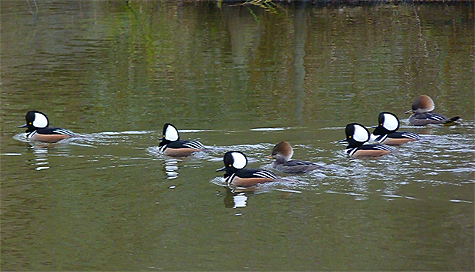
One minute they’re swimming along peacefully, the next they shift into display mode.
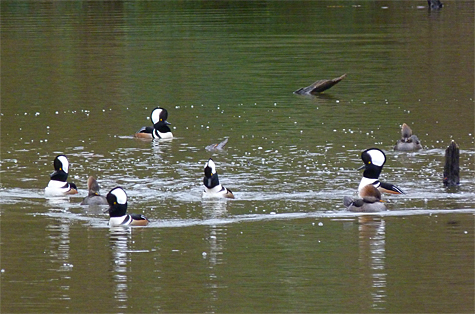
The mergansers are, for the most part, winter visitors here. And so are Hermit Thrushes.
One of the best places to see a Hermit Thrush here at the Museum is along the path between The Lemur House and Catch the Wind. There are other locations, but that portion of the trial is quiet and has the shrubs and trees that the hermit seeks in winter, sumac, holly, and there’s a privet just up the path. Berries and seeds are the thrush’s main diet in winter and those plants, among others, supply the hermit with what it needs.
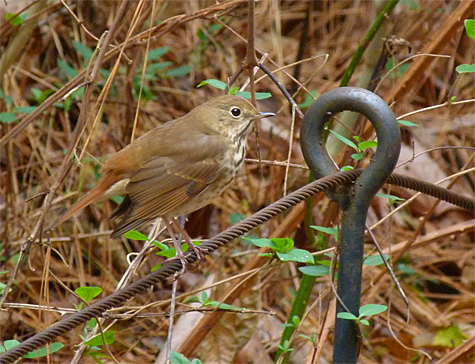
The Hermit Thrush gets its name from its solitary nature and woodland habitat. It’s certainly the only “brown” thrush to be found in these parts in winter. But the name most likely derives from its preferred habitat during the breeding season, northern mountain forests.
Other brown thrushes, Gray-cheeked, Swainson’s and Wood Thrush and Veery also breed in forests. All except the Wood Thrush breed exclusively in northern forest, but it’s the hermit who acquired the name “Hermit Thrush.” They also breed here in the mountains of North Carolina but you have to go up to the spruce/fir zone to see or hear them. Only the Wood Thrush breeds locally.
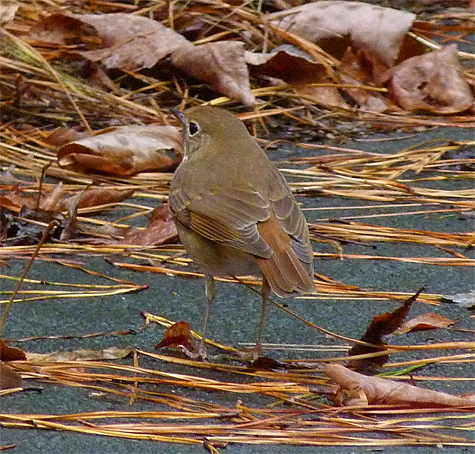
All of the brown thrushes have an airy, ethereal quality to their songs, which are typically only sung on the breeding grounds. We hear Wood Thrush singing each summer here at the Museum and it is a delight to hear but the other thrushes nest much further north. However, our wintering Hermit Thrushes may “tune up” a bit before leaving for the breeding grounds. But, if you want to hear the whole song the way it should be heard, up on a mountain top or in the great northern spruce/fir forest, you should plan a trip to do so, it’s worth the effort.
A few weeks back I mentioned that I had gotten a photo of a bird that I struggle with, photographically, that is, Brown Creeper. Here’s another bird that gives me trouble.
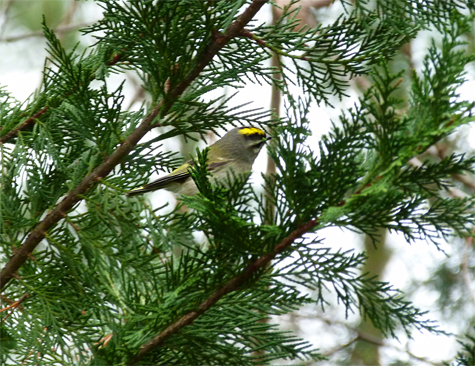
Kinglets are very small, a fraction over three inches, and they don’t sit still. Looking in a field guide, you might see the words very active and frenetic as part of this bird’s description. There are two kinglet species in our area in winter, Ruby-crowned and Golden-crowned. The ruby variety is more common than the golden. Hard enough getting a shot of a ruby-crowned, which I see more often, but the golden topped kinglet gives me a headache.
Locating a golden-crowned is not easy. As you can see by the above photo they don’t stay out in the open for long and it’s getting more difficult each year for me to hear their very high-pitched calls (the high frequencies go first). Unfortunate, since it’s their calls that often alert one to their presence.
I did manage a photo last month as a cold front delivered kinglets from the north. I must admit though, that neither photo is a great photo, but at least in this shot (above) you can clearly see where the bird gets its name. I will strive to improve.
Since this post is titled Winter Visitors, I might as well include an update on the Snowy Owl situation. There have now been 6 (I think) Snowy Owls reported in North Carolina. One is in rehab in Asheville, apparently malnourished.
The snowys that come this far south are typically young birds and they’re looking for food. It’s not a winter vacation in the mild south for these birds. Most birds, of any species, are reluctant to leave an area where food is abudant, no matter the temperature. Wish these owls luck, they need it.
Hey Greg:
Am enjoying reading your posts and seeing your images. What lens are you using to get the shots of the mergansers? Just wondering how approachable they are as I would love to get some photos. They are one of my favorite birds.
Thanks, Mike.
No special gear here. I’m using a Lumix FZ40, essentially a point and shoot camera. I do a lot of enlarging on images used in the blog.
No one hassles the mergansers here at the museum, but they are a bit shy. With a long lens, though, you should be able to get some great shots of our mergs. There are tons of green and bullfrog tadpoles huddled up against the shoreline of the wetlands and many, many shiners for them to feast on. As long as the water’s not frozen, which doesn’t happen often, you should do well. They come and go, but there’s a core group of about eight that hang out here regularly (peak was twenty-two about a week and a half ago).
Good luck,
While Explore the Wild is the best place to see these birds, visitors can also see Greg’s bird photos inside the museum. Visit his photo exhibit on the second floor, next to Investigate Health!